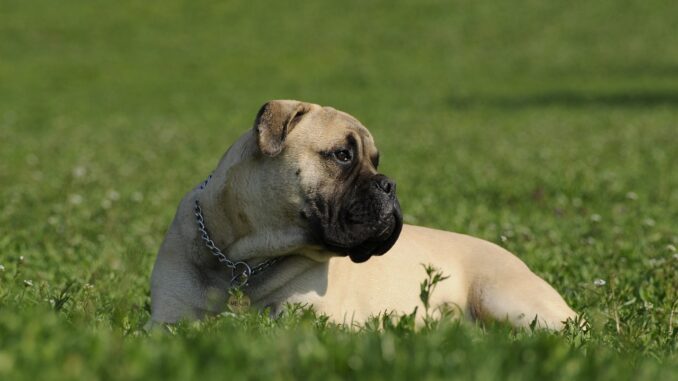
[ad_1]
Bullmastiffs, with their imposing size and powerful build, often evoke a sense of intimidation. Their historical role as a guard dog adds to this perception. But is this breed truly aggressive, or is there more than meets the eye? Let’s delve into the temperament of Bullmastiffs and discover how factors like training and environment influence their behavior.
Bullmastiffs: A Brief Overview
Originally bred in England during the mid-19th century, Bullmastiffs are a cross between Bulldogs and Mastiffs. Their primary role was to deter poachers by tracking and pinning them down without causing harm. Their lineage and the job they were bred for may hint at their nature: strong, loyal, and protective, but not unnecessarily aggressive.
Inherent Temperament of Bullmastiffs
By nature, Bullmastiffs are loyal, loving, and dependable. They form strong bonds with their families and are often gentle giants, especially around children. However, due to their protective instincts, they can be wary of strangers, displaying an aloof or reserved demeanor rather than outright aggression.
The Impact of Training on Bullmastiffs’ Behavior
Proper training is crucial for any dog breed, and it’s no different for Bullmastiffs. Given their size and strength, it’s imperative that Bullmastiffs receive consistent training from a young age.
- Socialization: Exposing Bullmastiffs to various environments, people, and other animals during their formative months helps in developing a well-adjusted adult dog. This early socialization minimizes any aggressive tendencies they might exhibit out of fear or unfamiliarity.
- Obedience Training: Teaching basic commands ensures Bullmastiffs understand their boundaries. Reward-based training methods work best, as these gentle giants respond well to positive reinforcement.
- Addressing Dominant Behaviors: Bullmastiffs can occasionally display dominant behaviors. It’s crucial for the owner to establish themselves as the pack leader, ensuring the dog understands its place in the family hierarchy.
Environmental Factors Affecting Bullmastiffs’ Temperament
The environment a Bullmastiff is raised in plays a significant role in determining its behavior. Stressful or hostile environments can lead to anxiety and aggression in dogs.
- Living Space: Bullmastiffs, like all dogs, thrive in environments where they have ample space to play and roam. Confined spaces can lead to pent-up energy and frustration, manifesting as aggression.
- Interactions: Regular positive interactions with both humans and other animals can shape a Bullmastiff’s temperament. Isolation or lack of social interactions can result in an overly protective or aggressive dog.
- Routine: Bullmastiffs, being creatures of habit, thrive on routine. A stable and predictable environment, where they’re aware of their boundaries, minimizes any behavioral issues.
Health and Its Influence on Bullmastiffs’ Behavior
Undiagnosed health issues can result in discomfort or pain for Bullmastiffs, leading to behavioral changes, including aggression. Regular veterinary check-ups and addressing any health concerns promptly can ensure your Bullmastiff remains in the best health, reflecting positively on its behavior.
The Protective Nature of Bullmastiffs
Bullmastiffs are, by nature, protective. They are hardwired to guard their families and territories. However, this protective instinct should not be mistaken for unwarranted aggression. Proper training ensures that Bullmastiffs can differentiate between genuine threats and benign situations.
Conclusion
In conclusion, while Bullmastiffs are naturally protective and can be wary of strangers, labeling them as aggressive would be an oversimplification. Their behavior, like any breed, is significantly influenced by their training, environment, and health. With the right upbringing, Bullmastiffs prove to be loving, loyal, and gentle companions. They epitomize the saying, “Don’t judge a book by its cover.”
Frequently Asked Questions About Bullmastiffs & Aggression

1. Are Bullmastiffs naturally aggressive?
No, Bullmastiffs are not naturally aggressive. They are bred to be guardians, which means they are protective and can be wary of strangers, but they are generally loyal, loving, and gentle with their families. Their initial purpose was to deter poachers without causing them harm.
2. How does early training impact a Bullmastiff’s temperament?
Early training is crucial for Bullmastiffs. Proper socialization from a young age helps them distinguish between genuine threats and benign situations, reducing the chances of aggressive reactions. Training also instills good behavior and helps manage their protective instincts.
3. How does the environment influence a Bullmastiff’s behavior?
Bullmastiffs, like all dogs, are influenced by their environment. A stressful or hostile environment can induce anxiety and possible aggression. Conversely, a stable, loving environment with regular social interactions and ample space can promote a well-adjusted temperament.
4. Are male Bullmastiffs more aggressive than females?
Both male and female Bullmastiffs are protective by nature. However, while individual temperaments can vary, there’s no concrete evidence to suggest that one gender is inherently more aggressive than the other. Proper training and socialization are more influential factors.
5. How should Bullmastiffs be introduced to strangers?
Given their protective nature, it’s crucial to introduce Bullmastiffs to strangers in a calm and controlled manner. Letting the stranger offer a treat or toy, and allowing the dog to approach at its own pace, can help foster positive interactions.
6. Is it safe to have Bullmastiffs around children?
Yes, with proper training and supervision, Bullmastiffs can be wonderful companions for children. They are often referred to as “gentle giants” and can be very affectionate. However, due to their size, it’s essential to supervise interactions to prevent accidental injuries.
7. Can Bullmastiffs coexist peacefully with other pets?
Yes, when properly socialized, Bullmastiffs can coexist peacefully with other pets. It’s beneficial to introduce them to other animals during their formative months to ensure harmonious relationships in the future.
8. What role does health play in a Bullmastiff’s aggression?
Undiagnosed health issues can lead to discomfort or pain, which may result in increased aggression or irritability. Regular veterinary check-ups can help address potential health concerns, ensuring a stable temperament.
9. How do I manage my Bullmastiff’s protective instincts?
Understanding and respecting their protective nature is essential. Training them to follow commands, providing them with a designated space, and using positive reinforcement can help manage their guarding instincts without suppressing them.
10. What are the benefits of adopting a Bullmastiff from a rescue or shelter?
Adopting a Bullmastiff from a rescue or shelter gives a dog a second chance at a loving home. Rescued Bullmastiffs often come with some basic training, and shelter staff can provide insights into their temperament. Additionally, adoption supports shelters in their mission to help more animals in need.
[ad_2]
Source link

Leave a Reply